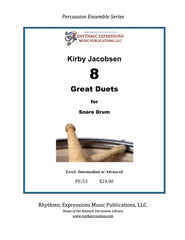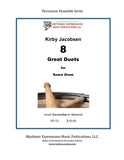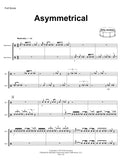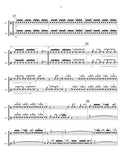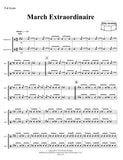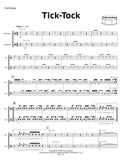Don't look now, but your school, church, or community band's holiday concert season is approaching fast! If you're looking for a complete set of percussion ensemble mu...
Shop by Category
Shop by Ensemble Size
8 Great Duets for Snare Drum (Digital Copy)
$24.00
Duets are fun to play! Whether it is for a recital, concert or special performance, these duets for snare drum are a great way to showcase your more advanced percussion students. These are recommended for advanced-level middle school through intermediate to advanced-level high school percussionists. Students will sharpen their skills performing in a variety of meters which include 4/4, cut-time and 6/8. Familiarity with rolls, flams and flam rudiments are necessary to perform these duets. Stickings are not indicated and are, therefore, not required to perform these duets. However, students should strive for rhythmic precision and observe dynamic markings carefully. I hope your students enjoy playing these as much as I enjoyed writing them.
Performance Notes Asymmetrical is a medium-tempo duet for two snare drums. This piece is best suited for high school level percussionists. Rhythmically, Asymmetrical consists of 16th, 1/8th, ¼, ½, and whole notes and rests; ¼ and 1/8th note triplets. Rolls should be felt as 16th notes. Therefore, a roll on an 1/8th note will be a 5-stroke, a roll on a ¼ note will be a 9-stroke and a roll on a ½ note will be a 17-stroke. Asymmetrical is introduced with trade-offs, in f, between the two snares. This continues through measure 9 with various dynamic levels being introduced. Snares are in unison leading into measure 17. Unison continues to measure 24 with intermittent trade-offs starting at measure 24. At measure 30, players take turns with one player performing a feature part and the other accompanying with a roll. Snares return to unison, from measures 42 through 46, as a segue. Starting at measure 46, the introduction is re-stated. This time, however, the parts are switched. Snare 2 plays what snare 1 played and vice versa. A short unison passage ends the piece.
Performance Notes Duet Symmetry is a medium-slow tempo duet for two snare drums. This piece is best suited for high school level percussionists. Rhythmically, Duet Symmetry contains 16th notes and triplets, dotted 1/8th and ample flam accents. Rolls should be felt as 16th note triplets. Therefore, a roll on an 1/8th note will be 7-stroke and a roll on a ¼ note will be 13- stroke. Duet Symmetry is introduced with trade-offs, in p, with snare 2 essentially echoing snare 1. Letter C is a sort of call-and-response. Some ‘responses’ are not a copy of the ‘call.’ Players alternate between call-and-response and unison at E. Letter F begins with a re-stating of the introduction, this time in mf, but with one measure echoes instead of two.
Performance Notes Duet Uno is a medium-tempo piece for 2 snare drums. This piece is suited for middle- to high school level percussionists. Rhythmically, Duet Uno consists of 1/8th, ¼, ½ and whole rests, 16th, 1/8th, ¼, ½ and notes. Rolls range from 9 through 17. Duet Uno is a classic snare drum duet, starting with a f unison introduction. The ‘trade-offs’ begin at measure 5, with a few unison measures interspersed. Rolls may be open or closed. Open rolls are employed in rudimental-style, marching band and drum core applications. Closed rolls are employed in the traditional, concert-style setting. Pay close attention to dynamics and crescendos and decrescendos for a more effective performance. The fermata roll at the last measure may be ended with a conductor’s cue, a visual cue or agreed-upon amount of time between the performers.
Performance Notes March Extraordinaire is a duet for two snare drums, in 6/8 time. It is faster than the traditional march tempo and is best suited for high school level percussionists. Rhythmically, March Extraordinaire contains 1/8th notes and rests, dotted ¼ notes with plenty of drags and flams. Rolls should be played with an 1/8th note feel. Therefore, a roll for a dotted ¼ note will be a 7-stroke, a roll for a ¼ note will be a 5-stroke and a roll for a dotted ½ note will be a 13-stroke. March Extraordinaire is introduced with both snares in unison and remains so until letter D. Letter D is where trade-offs start - 4 measures each. The amount of measures for each snare doubles to 8 from letter E to F. Letter F functions as a segue to letter G where the theme at letter A is re-stated. Snares are in unison here, once again, and remain so until the end. At letter G, f is introduced and remains in effect until the end.
Performance Notes Meter Made is an up-tempo duet for two snare drums. It is best suited for high school level percussionists. Its name is derived from the multiple meters it contains, from 3/4 to 6/4. Rhythmically, Meter Made contains 1/8th notes and rests, 16th notes and rests and ¼ and 1/8th note triplets and rests. Most rolls should be played with an 1/8th note triplet feel. Therefore, a roll for on a ¼ note will be a 7-stroke. Rolls for 1/8th notes should be felt as 16th notes. Therefore, a roll for an 1/8th note will be a 5-stroke. Meter Made is introduced with linear interplay between the 2 snares, with alternating 4/4 and 3/4 meters. There is no main or reoccurring theme in this duet. Each rehearsal letter introduces new rhythm patterns. Letter C is where the trade-offs begin, with one snare performing accented 1/8th notes with rests while the other accompanies with unaccented 1/8th notes. Letter D features more interplay, only this time in p. At letter E, trade-offs are unaccompanied. From letter F and continuing to the end, snares are in unison, in f. They perform primarily accented 1/8th notes in 5/4 and 6/4 meters.
Performance Notes Rollin’ Together is a slower-tempo duet for two snare drums. It is best suited for high school level percussionists. While the tempo is slow, rhythmically, it is rife with 16th notes and 16th triplets. Rhythms in Meter Made range from ½ notes to 16th note triplets. Most rolls should be played with a 1/16th note triplet feel. Therefore, a roll for an 1/8th note will be a 7-stroke, a roll for a ¼ note will be a 13-stroke. In the 5th and 6th measures after letter B, rolls should be felt as 16ths, making them all 5-stroke rolls. Meter Made is introduced in unison, in f. Letter A alternates between unison and trade-offs. Trade-offs are in full effect at letter B. Letter C returns to unison as a segue to letter D. Letter D introduces an interplay among the 2 snare drums, in p, with heavily accented flams. Letter E is reminiscent of the introduction and is primarily in unison. Careful attention should be paid to the dynamic changes here.
Performance Notes Soul Duet is an up-tempo duet for two snare drums, in cut time. This piece is suited for advanced middle school to high school level percussionists. Rhythmically, Soul Duet has ample 1/8th notes and rests, ¼ note triplets and rests and single 1/8th and ¼ note syncopation. Rolls should be felt as 1/8th notes. Therefore, a roll on a ¼ note will be a 5-stroke, a roll on a ½ note will be a 9-stroke and a roll on a dotted ½ will be a 13-stroke. Soul Duet is introduced with snare 1 performing the main 2-bar theme, unaccompanied. Snare 2 accompanies snare 1 at measure 9 with steady 1/8th notes on the rim. Snares are in unison 4 bars before they arrive at letter A. Volume is then decreased as both snares continue in unison, performing accented 1/8th notes. At letter B, snare 2 performs a repetitive, accented 2-bar phrase. Snare 1 accompanies with accented 1/8th notes on the rim that, intermittently, contrasts the accents played by snare 2. At letter C, snare 1 continues with a variation of this 2-bar phrase while snare 2 now contrasts the accents played by snare Snare 1 also contrasts by hits on the snare head. Snares return to unison 4 bars before letter D, where trade-offs occur. The first 4 bars at letter F function as a segue back into the main theme, which is now performed by both snares, in unison.
Performance Notes Tick Tock is a medium tempo duet for two snare drums. This piece is best suited for high school level percussionists. Rhythmically, Tick Tock ranges from ¼ notes, ¼ and 1/8th note triplets to mixed 1/8th and 16th note patterns with rests. Rolls should be felt as 1/16th notes. Therefore, a roll on an 1/8th note will be a 5-stroke, a roll on a ¼ note will be a 9-stroke and a roll on a ½ note will be a 17-stroke. Rolls on the ¼ note triplets, 4 bars after letter E, should be 7-stroke. Tick Tock is introduced with both snares performing a “tick tock” pattern on the rim. This effect is achieved by snare 1 performing the “tick” and snare 2 performing the “tock.” At letter A, both snares perform contrasting patterns on the rims, simultaneously. Both snares switch to playing on the heads at letter B. They continue to play contrasting rhythm patterns but switch to unison every two bars. From letters C to D, snares once again perform the “tick-tock” pattern with added, intermittent “alarms,” represented by rolls. Both performers should pay careful attention here: the tick-tock is now p and alarms are f. Letter D functions as a variation of the tick-tock-alarm effect. Letters E to G feature overlapping trade-offs, with changing dynamic levels. Letter G to the end is performed in unison. Dynamic levels change rapidly so careful attention is a must. At letter H, a classic march-style cadence is introduced and continues to the end.
